Kasbah of Marrakesh
The Kasbah of Marrakesh is a large walled district in the southern part of the medina of Marrakesh, Morocco, which historically served as the citadel (kasbah) and royal palace complex of the city. A large part of the district is still occupied by the official royal palace, the Dar al-Makhzen, which serves as the residence of the King of Morocco when visiting the city, while the rest is occupied by other neighbourhoods and monuments.
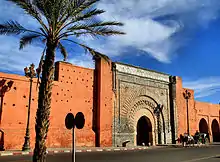
History
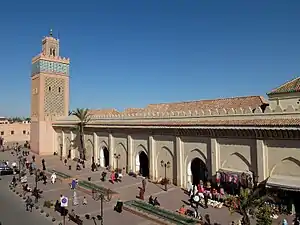
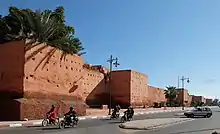
The Almohad kasbah
The first citadel and royal residence of Marrakesh was the fortress and residence known as the Ksar el-Hajjar built by the Almoravid leader Abu Bakr ibn Umar when he founded the city in 1070.[1][2] This fortress was located just north of the current Kutubiyya Mosque. The later Almoravid emir Ali ibn Yusuf (ruled 1106-1143) attached a palace to the south, on the site of what is now the mosque. Remains of these Almoravid structures have been excavated and the remains of a stone gate called Bab 'Ali, belonging to Ali's palace, are still visible today alongside the ruins of the first Kutubiyya Mosque.[2][3]
When the Almohad ruler Abd al-Mu'min conquered Marrakesh in 1147, he reportedly destroyed many Almoravid monuments (especially mosques) but the Ksar el-Hajjar and the palace of Ali ibn Yusuf were still used as the official residence of the new Almohad rulers for a time.[2][1] The Almohad caliph Ya'qub al-Mansur (ruled 1184-1199), however, embarked on an ambitious construction project to create a vast new royal district attached to the south side of the city. (Some sources cite his predecessor Abu Ya'qub Yusuf as the first one to found the kasbah,[4][5] but most of the work is usually attributed to al-Mansur.[2][1][6]) This new citadel and extension of the city was known in historical sources as the Kasbah (or Qasaba), as well as Tamurakusht and as-Saliḥa.[6]:320 It was built over the site of an earlier Almoravid garden estate known as as-Saliḥa, of which only the eastern portion remained afterwards (later replaced by the present-day Mellah).[2]:195[5] The construction of the kasbah was motivated in part by the rapid growth of the city's population and an urgent need for more space within the city.[6] However it may also have been motivated by the Almohad caliph's desire to follow the example of other powerful Islamic rulers who built separate palace-cities from which to rule, such as the Umayyad construction of Madinat al-Zahra near Cordoba or the Abbasid construction of Samarra in Iraq.[2] Construction of the Marrakesh kasbah began in 1185 and finished by 1190, though al-Mansur's successors continued to build more palaces within it until there were a total of twelve by the end of the Almohad period.[2][1][6]
.jpg.webp)
The Almohad kasbah was a vast self-contained district surrounded by ramparts and further subdivided by other walls within. It included not only the royal palace (known as the Dar al-Khalifa[2] or Qasr al-Khilafa[6]), but also its own great mosque (the Kasbah Mosque), its own markets and qaysariyya (bazaar), a madrasa, bathhouses (hammams), warehouses, stables, cemeteries, gardens, and squares.[2][1][6][7] The expansion of the city also included the foundation of a hospital (maristan), though the location of this establishment (now disappeared) is unclear.[2][6] The main public entrance to the kasbah was Bab Agnaou, located in the kasbah's northwestern corner and accessed from inside the city walls.[2][1] Despite some modifications, it is still well-preserved today and features extensive stone-carved decoration. Another gate, Bab as-Sadat, allowed direct entrance into the kasbah from outside the city walls but was reserved for high officials and members of the royal dynasty.[2] The Almohads also established vast pleasure gardens around the kasbah, such as the Agdal Gardens to the south which were surrounded by their own walls.[1][2][8] A gate known as Bab al-Bustan allowed direct access between the caliph's palace and the gardens.[2]
The kasbah was divided into three parts by inner walls which each had their own gates. The largest section was the caliph's palaces, covering about 24 hectares and occupying the whole eastern side of the kasbah.[2]:218 The second division was in the southwest corner, taking up about 12 hectares, and contained the various services required by the palace and government.[2] Notably, this district was centered around a large square or plaza known as the asaraq and which was the early equivalent of a mechouar.[2] The third section, more publicly accessible, occupied 8 hectares in the northwestern corner of the kasbah and contained the Kasbah Mosque and its annexes, as well as another square in front of the mosque. This square was also known as the asaraq, but was smaller than the other one in the district to the south. A main street ran in a straight line from north to south and connected the two squares; though the larger asaraq has since disappeared.[2][1]:245 The street, which still exists today in the fabric of the neighbourhood, was lined with porticos and accessed at either end by two gates known as Bab at-Tubul (to the north) and Bab as-Saqa'if (to the south).
Aside from the mosque and the main gate of Bab Agnaou, almost none of the Almohad structures have survived intact to this day.[7][8] The current western and southern outline of the kasbah today, including its walls, most likely still date back essentially to the Almohad construction, but many other ramparts and gates have been changed since.[2]:214
The Saadian period
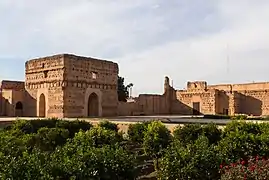
Following the demise of the Almohad regime, Marrakesh as a whole fell into decline as the following Marinid dynasty made Fes their capital and carried out few major constructions in the city. It wasn't until the Saadian Dynasty (16th century to early 17th century) established Marrakesh as their capital that the city and its kasbah saw a resurgence. The Saadians established themselves in the old Almohad kasbah and undertook their own renovations and reconstructions. Sultan Moulay Abdallah al-Ghalib constructed new palaces and annexes in the northern part of the kasbah and repaired the Kasbah Mosque after it was damaged in a gunpowder explosion in the 1560s or 1570s.[9] He also began the Saadian Tombs on the south side of the mosque. Finally, it was he who transferred the Jewish population of the city to a new Mellah, on the east side of the Royal Palace, thus expanding the eastern outline of the kasbah.[2][9]
.jpg.webp)
Sultan Ahmad al-Mansur, who oversaw the apogee of Saadian power, undertook another series of constructions and renovations. He built the most elaborate mausoleums in the Saadian Tombs and, most of all, constructed a superlative palace known as El Badi.[2][9] The palace was used for the reception of ambassadors and other guests and was designed as a showcase of al-Mansur's power and wealth, making use of the most lavish materials and decoration, such as imported Italian marble.[9]
The Saadian palace complex of this period was entered via a "Grand Mechouar", a vast ceremonial square or courtyard on the site of the former asaraq square, to the south of the Kasbah Mosque.[9] The main gate of the royal palace was situated here and led to a smaller mechouar from which a long passage ran east to give access to the palace's various components. On the south side of this passage were most of the functional annexes of the palace, including kitchens, warehouses, the treasury, and stables.[9] On the north side of the passage was the vast reception palace (the El Badi Palace), along with the private quarters of the sultan and his family, their bathhouses (hammams), a private mosque, and the mint.[9] Finally, beyond these structures, occupying the whole eastern side of the kasbah, were a number of pleasure gardens. These included the Crystal Garden (az-zujaj), the royal garden known as al-Mustaha ("the Desired") with a grand water basin, and the Qasr Garden or inner garden for al-Mansur's private quarters.[1][9]:256 Ahmad al-Mansur also renovated the vast Agdal Gardens to the south of the kasbah.[9] Lastly, sources from this period also describe and illustrate a tall tower rising out of the middle of the palaces and visible from afar. This tower is of uncertain origin and later disappeared during the Alaouite era, but may have been an observation tower built for the enjoyment of the sultan.[1]
.jpg.webp)
Alaouite period to present
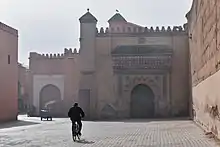
After the decline of the Saadian dynasty the kasbah was severely neglected in turn, as the Alaouite dynasty that followed them rarely used Marrakesh as their capital. Moulay Isma'il, in particular, plundered the Saadian palaces for materials (such as marble) to use in his own palace and kasbah that he was building in Meknes. The Badi Palace became a ruin, though the Saadian Tombs were still used as royal necropolis for some members of the Alaouite royal family.[9] There were notable exceptions to this relative neglect such as the reign of Moulay Muhammad ibn Abdallah, who ruled Marrakesh as governor for his father from 1746 and then used it as his unofficial capital as sultan between 1757 and 1790.[2][1] He undertook new construction of palaces and gardens, as well as building a new mosque, the Barrima Mosque.[2] He also expanded or developed the kasbah on its south side, creating a number of new mechouars (walled squares) as part of the approach to the royal palace, whose entrance was now reoriented to the south (as opposed to the west, as it was in Almohad and Saadian times).[2]
Up to the late 19th century and early 20th century, the kasbah was still the center of power in Marrakesh and wealthy government ministers also built their own palaces and mansions near it. The most famous of these is Bahia Palace, later turned into a royal palace.[1][10] The Agdal Gardens were also maintained and occasionally replanted, with new royal pavilions constructed within them and even new fortifications constructed on their west side.[2]
Layout of the Kasbah today

Today, the kasbah is no longer a closed district and much of it is accessible to the public. It is located on the south side of the main medina. Its western sections are filled with residential structures. Most of its eastern section, however, is still being used as the Royal Palace (Dar al-Makhzen) for the King of Morocco and is off-limits to the public. The royal palace grounds, much modified under the Alaouite dynasty, contain vast gardens and plazas. At their northern end, however, the remains of the monumental El Badi Palace, built by the Saadian sultan Ahmad al-Mansour and subsequently ruined, are now a historic site accessible to tourists.[10]
In the northwest area of the kasbah is the citadel's original main mosque, the Kasbah Mosque (also known as the Mansuriyya Mosque and the Mosque of Moulay al-Yazid), still active today and accessible only to Muslims.[10] Just west of the mosque, at the junction between the main city's walls and the outer walls of the kasbah, is the former main public gate of the kasbah, Bab Agnaou, built under the Almohad ruler Yaqub al-Mansur.[2] Near the kasbah, to the north, past Place des Ferblantiers, is also the Bahia Palace.[10]
The area between the mosque to the west and the El Badi and Dar al-Makhzen palaces to the east used to be part of the royal palace itself or its annexes, but today it is occupied by residential neighbourhoods. The shape and outline of certain streets here still reflects the outline of earlier walls or structures which have since disappeared. The main street of the kasbah (Rue de la Kasbah today), running roughly north to south between the mosque to the north and the Derb Chtouka neighbourhood to the south, dates back to the original asaraq avenue which has existed since the original Almohad foundation.[2][1]
The kasbah is flanked to the east by the former Jewish district of the city, the Mellah, south of which is another neighbourhood from recent centuries called Bab Ahmar or Bab Hmar (named after the nearby gate of the same name).[2] To the west the kasbah is flanked by largely open ground. At the southern end of the kasbah and of the city stretch out the vast Agdal Gardens, which are enclosed in their own set of walls connecting with the walls of the kasbah.[1] Between these gardens and the Royal Palace are several large open squares or courtyards which serve as a series of mechouars, dating from the Alaouite period, and constitute the main approach to the Royal Palace today.[2]
The Royal Palace today
Overview
The Royal Palace of Marrakesh, known as the Dar al-Makhzen ("House of the Government"), is still used as an official royal residence today and is off-limits to the public. While the palace complex historically encompassed most of the kasbah, it occupies a slightly more limited space today.[1] The current structures and gardens of the palace date mainly from the Alaouite period, mostly from the time of Moulay Muhammad ibn Abdallah in the 18th century.[2] Construction on the main part of the palace, consisting of the Arsat an-Nil garden and its surroundings, was begun in 1747, when Muhammad was still viceroy under his father Abdallah. According to historian Gaston Deverdun,[2] the northern parts of the palace were probably first finished in 1753-54 but then were rebuilt or remodelled between 1760 and 1765 when Muhammad was sultan. The southern parts of the palace were probably finished before 1760, and the palace as a whole, including some of the outlying structures around the mechouars, were finished in the 1760s. There is evidence, however, that Muhammad continued to carry out works later in his reign and that he also enlisted European craftsmen (particularly from Spain) for many of its elements.[2]:481–482 The original 18th-century palace was arranged in a very regular and symmetrical fashion reflecting a riad-style layout, but subsequent constructions have added some slightly asymmetrical elements.[2]:482–483 A state prison was also created by Muhammad within the grounds and annexes of the old Badi Palace, immediately adjacent to the new Alaouite palace.[2]:485
The mechouars
.jpg.webp)
The palace's main entrance today is in the south. It is approached via a series of walled courtyards or official squares known as mechouars (also spelled meshwar), a common feature of traditional royal palaces in Morocco.[2][1] These occupy a large space between the palace to the north and the Agdal Gardens to the south. The mechouars, arranged in a series from roughly east to west, are accessed through a number of gates – although many are of minor historical or architectural interest. The first (outermost) gate to the east is Bab Ahmar ("Red Gate"; also spelled Bab Hmar),[11][1] and is the most notable due its incorporation of a large guardhouse and a terrace that could hold light artillery.[2]:497 Behind this gate is a neighbourhood of the same name and a street running west to Bab al-Furma, a gate which in turn leads to the Outer Mechouar (also known as Mechouar al-Barrani). This mechouar is a large rectangular plaza measuring around 200 by 240 metres, located directly south of the Mellah and Barrima neighbourhoods on the east side of the palace.[2]:498 West of this mechouar is a narrower rectangular mechouar, the Inner Mechouar (also called Mechouar al-Wastani), measuring around 200 metres on east-west axis and 90 meters on its north-south axis. It is entered from the east via the Bab er-Rih gate. On the north side of this mechouar is the official main gate to the palace, Bab al-Akhdar. On the west side of this mechouar is an unnamed gate over which a protected passage along the wall allowed for direct access between the palace to the north and the Agdal Gardens to the south.[2]:498 This gate in turn led west to the largest mechouar, the Grand Mechouar (also called Mechouar al-Awwali), occupying a large open area measuring 360 meters on its north-south axis and 180 meters on its east-west axis. A gate at its northeastern corner, called Bab Bu 'Uqqaz, also leads to the palace and was traditionally used to receive ambassadors. Among the other ceremonies that took place in this mechouar were Lastly, another gate to the west leads to a narrow walled road that runs to the westernmost gate of this area, Bab Ighli, located at the southwest corner of the kasbah's walls.[2]:499
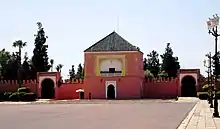
At the southern end of the Grand Mechouar, at the edge of the Agdal Gardens, is a menzeh (observation pavilion) known as the Qubbat as-Suwayra ("Pavilion of Essaouira"), so-called because its construction was most likely funded by tax revenues from Essaouira. It dates from the reign of Muhammad ibn Abdallah and was most likely finished in the 1760s, like the rest of the palace. This pavilion is built over the wall between the mechouar and the gardens and externally distinguished by the usual green-tiled pyramidal roof. The heavy pillars and walls at ground level uphold a large square chamber above, which was heavily decorated with zellij tiling and painted wood ceiling. This room also gives access to a loggia on its north side that allowed the sultan to observe ceremonies in the mechouar and to a small open terrace on its south side which allowed him to admire the view of the Agdal Gardens and of the Atlas Mountains in the distance. The northern loggia features a wide arch on its outer façade whose spandrels are decorated with floral arabesques. Above it is an Arabic inscription in red. The pavilion was likely built with the help of European masons and at least one source, cited by historian Gaston Deverdun, claims the architect was a Spaniard sent by Charles III to Muhammad ibn Abdallah in friendship.[2]:499–500
The palace grounds
The interior of the palace consists of various gardens and courtyard surrounded by chambers and pavilions. It is dominated by the largest riad garden in Marrakesh, the Arsat an-Nil ("Garden of the Nile"), named after the Nile River allegedly because it was planted with flora from Egypt. Measuring around 130 meters on its north-south axis and 70 meters on its east-west axis, it is divided along its middle by a path from north to south, which in turn is intersected by several other perpendicular paths.[1]:283–284[2]:483[3]:397 The palace structures are divided in two main groups: one to the north of the garden and one to the south. Along the west side of the garden is a row of structures that housed private apartments for the sultan as well as a small mosque and other facilities. On the east side of the garden is a gate that leads to the Barrima Mosque, the official mosque of the palace built by Muhammad ibn Abdallah.[2][3]
The structures on the north side of the Arsat an-Nil, known collectively as al-Qasr al-Akhdar ("the Green Palace"), are arranged around two large rectangular courtyards, formal in appearance and enclosed by white walls behind which are various rooms and smaller inner courtyards. The main northern courtyard, which touches the southeast corner of the El Badi Palace, is the simplest in form but contains a fine pavilion decorated with zellij tiles and facing a fountain. Its perimeter is surrounded by richly-decorated rooms. The main southern courtyard (measuring 34 by 28 meters) is open on its south side to the Arsat an-Nil garden. At the middle of its northern side is a large reception hall known as the Sattiniya, distinguished by its large pyramidal green roof and richly decorated inside. The hall is entered from the south via a triple-arched portico, in front of which, at the middle of the courtyard, is a large square pool of water. This symmetrical arrangement and the courtyard's openness on one side allows for a grand approach to the Sattiniya from the Arsat an-Nil gardens. The palace wing on the east side of this same courtyard was the historic residence of the sultan's hajib (chamberlain), while the wing on the west side of the courtyard included facilities such as kitchens and storage rooms. The west wing is also topped by an observation belvedere called the Menzeh ar-Radhi, with views on the courtyard and the main garden.[2]:483[3]:397
The main structure on the south side of the Arsat an-Nil is ad-Dar al-Kebira ("the Great House"). It originally consisted of one vast courtyard around which were three secondary courtyards. The courtyard was entered from the south via a series of gates including Bab al-Akhdar (the outer gate and entrance to the palace from the mechouars). The whole ensemble was strongly symmetrical and arranged to form a grand approach to the main gardens to the north. It once included an hexagonal pool of water and the usual green pyramidal roofs which were all aligned with the central axis of the Arsat an-Nil. However, since the 18th century various other structures and rooms have been added or modified in this area, such that it has now lost its symmetry. It still has a large symmetrical courtyard featuring two halls with pyramidal roofs that face each other at either end of its east-west axis, but the surrounding structures have a very irregular layout.[2]:484[3]:397
See also
References
- Wilbaux, Quentin (2001). La médina de Marrakech: Formation des espaces urbains d'une ancienne capitale du Maroc. Paris: L'Harmattan. ISBN 2747523888.
- Deverdun, Gaston (1959). Marrakech: Des origines à 1912. Rabat: Éditions Techniques Nord-Africaines.
- Marçais, Georges (1954). L'architecture musulmane d'Occident. Paris: Arts et métiers graphiques.
- Arnold, Felix (2017). Islamic Palace Architecture in the Western Mediterranean: A History. Oxford University Press. p. 197. ISBN 9780190624552.
- Navarro, Julio; Garrido, Fidel; Almela, Íñigo (2017). "The Agdal of Marrakesh (Twelfth to Twentieth Centuries): An Agricultural Space for Caliphs and Sultans. Part 1: History". Muqarnas. 34 (1): 23–42.
- Bennison, Amira K. (2016). The Almoravid and Almohad Empires. Edinburgh University Press.
- Salmon, Xavier (2018). Maroc Almoravide et Almohade: Architecture et décors au temps des conquérants, 1055-1269. Paris: LienArt.
- Bloom, Jonathan (2009). "Marrakesh". The Grove Encyclopedia of Islamic Art and Architecture. Oxford University Press. pp. 164–165.
- Salmon, Xavier (2016). Marrakech: Splendeurs saadiennes: 1550-1650. Paris: LienArt. ISBN 9782359061826.
- Lonely Planet: Morocco (12th edition). Lonely Planet. 2017. ISBN 9781786570321.
- Insight Guides: Explore Marrakesh. Apa Publications Limited. 2019. ISBN 9781789198072.